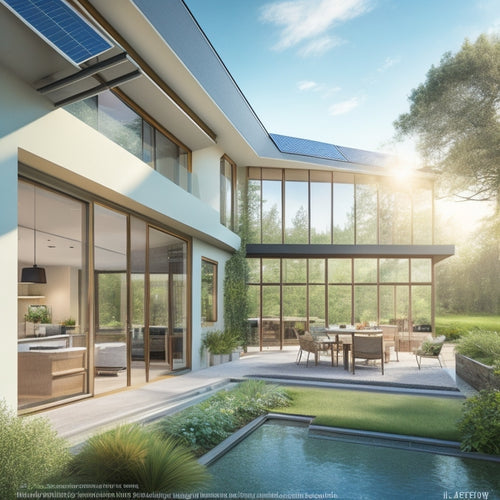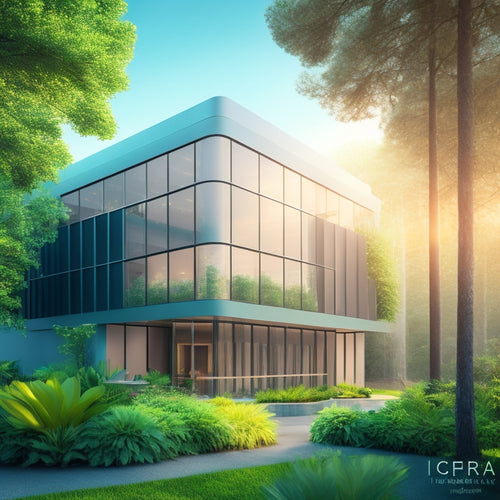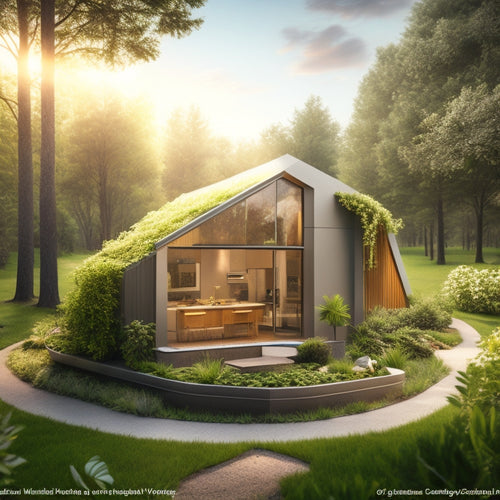
7 Earth-Friendly Building Materials for Your Green Home
Share
You're on a mission to build a green home that's as eco-friendly as it is stunning. You're in luck! From natural insulation options like cellulose and wool to low-carbon cement alternatives and sustainable steel choices, the possibilities are endless. Reclaimed wood adds a touch of history and character, while bamboo and recycled glass countertops bring durability and style. Earthy plaster finishes and geopolymer cement reduce your carbon footprint without compromising on aesthetics. As you investigate these 7 earth-friendly building materials, you'll unveil a world of innovative solutions that will take your dream home to the next level - and there's still so much more to reveal.
Key Takeaways
- Natural insulation options like cellulose and wool reduce energy consumption and promote healthier indoor environments.
- Reclaimed wood reduces carbon footprint by up to 50% compared to virgin materials and adds unique aesthetic appeal.
- Low-carbon cement alternatives like geopolymer cement and bio-based binders reduce emissions by up to 80% without compromising durability.
- Bamboo is a versatile, durable, and sustainable material suitable for flooring, framing, and insulation with higher tensile strength than steel.
- Recycled glass countertops offer a unique aesthetic, are highly durable, and contribute to reducing landfill waste and conserving natural resources.
Natural Insulation Options
About 30% of the energy consumed in buildings is lost due to inadequate insulation. You can break free from this energy-wasting cycle by choosing natural insulation options that not only reduce your carbon footprint but also promote a healthier living space.
Consider cellulose insulation, made from recycled paper products, which is a cost-effective and eco-friendly alternative to traditional fiberglass insulation. Another option is wool insulation, a sustainable and renewable resource that provides exceptional thermal performance.
By integrating renewable energy conversion kits into your home's infrastructure, you can further reduce emissions and contribute to climate leadership. Both of these natural insulation options are breathable, reducing the risk of moisture buildup and promoting a healthier indoor environment.
Reclaimed Wood Benefits
You'll love the unique textural patterns that reclaimed wood brings to your building project - every plank tells a story of its past life.
By choosing reclaimed wood, you're also reducing your carbon footprint, as it eliminates the need to harvest and process new lumber.
With the increasing adoption of electric and hybrid vehicles, it's crucial to evaluate the environmental impact of our building materials as well.
This eco-friendly approach not only helps the planet, but it also adds character to your build.
Unique Textural Patterns
Through the careful selection of reclaimed wood, designers and builders can incorporate unique textural patterns into their designs, imbuing spaces with a distinctive character that echoes the material's rich history.
By leveraging renewable energy sources, such as solar panels for commercial vehicles, homeowners can further reduce their carbon footprint and create a more sustainable living space.
As you investigate the world of reclaimed wood, you'll uncover a vast array of textural aesthetics, from the rustic charm of old barn wood to the refined sophistication of salvaged industrial flooring.
By incorporating these organic designs into your green home, you can create a space that's not only visually stunning but also deeply connected to the natural world.
Reduced Carbon Footprint
One significant advantage of specifying reclaimed wood in your building project is that it can help slash carbon emissions by up to 50% compared to using virgin materials.
By choosing reclaimed wood, you're reducing the demand for newly harvested wood, which in turn reduces the energy needed for logging, processing, and transportation. This leads to significant energy efficiency and a lower carbon footprint.
Additionally, incorporating renewable energy sources, such as solar power, into your project can further reduce emissions and contribute to a more sustainable future.
By leveraging energy storage solutions, you can guarantee a reliable energy supply and reduce your reliance on fossil fuels.
Reclaimed wood can be used to offset carbon emissions from other aspects of your project, allowing you to achieve a more balanced environmental impact.
Low-Carbon Cement Alternatives
As the construction industry continues to grapple with its massive carbon footprint, innovators are turning to low-carbon cement alternatives that can greatly reduce greenhouse gas emissions.
You're likely familiar with traditional cement's high carbon cost, but did you know that geopolymer cement can slash emissions by up to 80%? This innovative material uses industrial by-products like fly ash and silica fume to create a durable, low-carbon concrete.
Furthermore, the integration of renewable energy sources solar and wind power in the production process can further reduce the carbon footprint of these alternatives.
Another breakthrough is bio-based binders, derived from renewable biomass sources like agricultural waste or forestry residues. These sustainable alternatives can replace traditional cement in various building applications, giving you the freedom to build your green home with a clear conscience.
Bamboo Building Possibilities
You're probably familiar with bamboo's eco-credentials, but you might be surprised by its versatility in building construction.
You can opt for bamboo flooring that's not only aesthetically pleasing but also highly durable.
As you investigate bamboo building possibilities, you'll uncover sustainable framing options and eco-friendly insulation choices that can considerably reduce your project's carbon footprint.
Bamboo Flooring Options
Bamboo flooring options have emerged as a top choice for eco-conscious builders and homeowners, and for good reason. As you consider this earth-friendly material, you'll appreciate its durability and aesthetic appeal.
Bamboo's unique properties make it resistant to scratches and dents, ensuring your floors remain looking fresh for years to come. Plus, its natural resistance to moisture and insects reduces the need for harsh chemicals, aligning with your values of freedom from toxic substances.
To maintain your bamboo floors, simply sweep or vacuum regularly and mop with a gentle cleaner. Enjoy the bamboo sustainability benefits, knowing you're reducing your carbon footprint while creating a beautiful, healthy living space.
Sustainable Building Frames
Beyond flooring, bamboo's potential extends to the very foundation of your eco-friendly build: sustainable building frames.
You're probably thinking, "How can bamboo possibly support the weight of an entire structure?" But bamboo's incredible strength and durability make it an ideal material for eco-friendly framing.
In fact, bamboo has a higher tensile strength than steel and can withstand extreme weather conditions.
Using bamboo for framing also reduces the carbon footprint of your build, as it requires minimal processing and transportation.
Plus, modular construction methods make it easy to assemble and disassemble bamboo frames, giving you the freedom to design and redesign your space as you see fit.
Eco-Friendly Insulation Choices
Insulating your eco-friendly build with sustainable materials is essential for maintaining a comfortable indoor climate while minimizing environmental impact.
You've got several eco-friendly insulation options to choose from. Consider cellulose insulation, made from recycled newspaper and treated with natural fire retardants. It's a cost-effective, high-performance choice that reduces landfill waste.
Another option is sheep wool, a natural, renewable resource that's breathable, moisture-wicking, and provides excellent thermal insulation.
You can also opt for recycled denim insulation, made from recycled jeans, or even repurposed materials like recycled glass or plastic.
Whatever you choose, rest assured you're making a conscious decision to reduce your carbon footprint and create a healthier living space.
Recycled Glass Countertops
As you investigate eco-friendly alternatives for your dream kitchen, consider the sparkling allure of recycled glass countertops. Made from post-consumer glass, these countertops reduce waste and conserve natural resources.
The design aesthetics are endless, with a wide range of colors and textures to choose from. Plus, recycled glass countertops are incredibly durable and resistant to scratches and heat.
When it comes to maintenance, simply clean with soap and water, and apply a sealant every 1-2 years to maintain their luster.
With recycled glass countertops, you'll enjoy a stylish, eco-friendly kitchen that not only looks fantastic but also helps reduce your carbon footprint.
Sustainable Steel Choices
Your dream kitchen's structure deserves a sustainable steel choice that aligns with your eco-friendly vision.
You're making a conscious decision to reduce your carbon footprint, and that's commendable. When it comes to sustainable steel production, look for manufacturers that employ steel recycling methods.
This process reduces the need for virgin materials, conserves natural resources, and decreases energy consumption. You'll be supporting a more circular economy while getting a durable, high-quality material for your kitchen's design.
By choosing sustainable steel, you're not only building a green home but also promoting a healthier environment for future generations.
Make the smart choice – opt for eco-friendly steel that aligns with your values and vision.
Earthy Plaster Finishes
You're now taking your eco-friendly kitchen design to the next level by exploring earthy plaster finishes that not only add a touch of natural charm but also support your commitment to sustainability. These finishes are made from natural materials like clay, lime, and earth oxides, which can be mixed with natural pigments to create unique, earthy tones. The application techniques vary, from traditional hand-applied methods to modern spray techniques.
| Finish Type | Characteristics | Benefits |
|---|---|---|
| Clay Plaster | Breathable, moisture-regulating | Reduces mold growth, improves indoor air quality |
| Lime Plaster | High pH, resistant to mold | Natural antibacterial properties, durable |
| Earth Oxide Plaster | Natural, earthy tones | Non-toxic, low maintenance, aesthetically pleasing |
| Natural Pigment Plaster | Customizable colors, natural hues | Unique design options, eco-friendly alternative |
| Tadelakt Plaster | Water-resistant, decorative | Durable, low maintenance, adds visual interest |
Frequently Asked Questions
Are Earth-Friendly Building Materials More Expensive Than Traditional Options?
When comparing costs, you'll find that eco-friendly options might be pricier upfront, but they offer long-term savings through energy efficiency, reduced waste, and lower maintenance, ultimately giving you the freedom to live sustainably without breaking the bank.
Can I Use Earth-Friendly Materials for DIY Home Renovation Projects?
Ha! You think the planet's gonna judge you for DIYing with non-eco materials? Newsflash: you're already a rebel for taking on a renovation project! So, go ahead, get creative with sustainable sourcing and eco-friendly finishes - your inner environmentalist (and the planet) will thank you.
Do Earth-Friendly Materials Require Special Maintenance or Care?
You'll find that many eco-friendly materials require minimal upkeep, but some, like low-VOC paints, may need special care; adopting sustainable practices and choosing eco-friendly finishes will guarantee your DIY project stays green and healthy for years to come.
Are Earth-Friendly Materials Suitable for Extreme Weather Conditions?
You'll be surprised to know that 60% of natural disasters occur in areas with subpar building standards. When building, you need materials that meet stringent sustainability standards and guarantee climate resilience, so your dream home can withstand extreme weather conditions.
Can I Mix Earth-Friendly Materials With Traditional Materials in a Project?
You can definitely combine eco-friendly materials with traditional ones, creating sustainable combinations through hybrid approaches that balance performance and environmental responsibility, giving you the freedom to design innovative, high-performing structures that align with your values.
Related Posts
-

5 Efficient Air Circulation Methods for Green Homes
You can utilize the power of natural ventilation techniques, whole house fans, and solar-powered ventilation systems ...
-

7 Top HEPA Filters for Green Building Projects
You need a reliable HEPA filter for your green building project that aligns with your sustainable goals and guarantee...
-

10 Best Sustainable Waste Management Solutions for Green Homes
You're likely unaware that the average green home generates over 2 kilograms of waste daily, but with the right susta...


